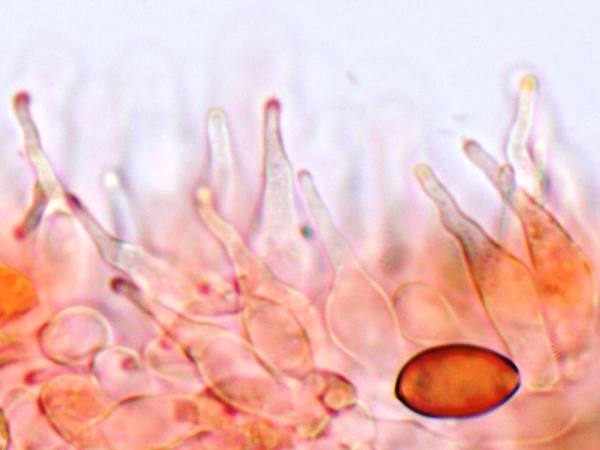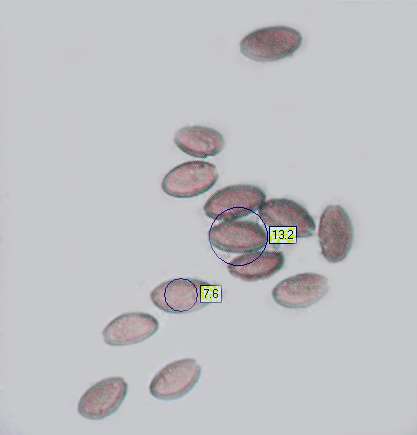Psilocybe semilanceata (Fr.) P. Kumm. - Magic Mushroom or Liberty Cap
Phylum: Basidiomycota - Class: Agaricomycetes - Order: Agaricales - Family: Strophariaceae
Distribution - Etymology - Taxonomic History - Psychoactivity - Identification - Reference Sources
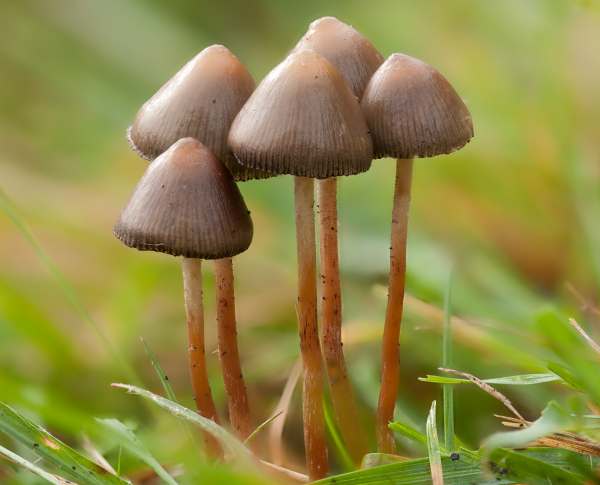
Psilocybe semilanceata, commonly known in the UK as the Magic Mushroom, and in the USA as Liberty Cap, appears in grassland in autumn. It is most commonly found on pasture and parkland that has not been enriched with artificial fertiliser.
Distribution
Fairly frequent in Britain and Ireland, where it is rather localised, Psilocybe semilanceata occurs throughout Europe and is found also in North America.
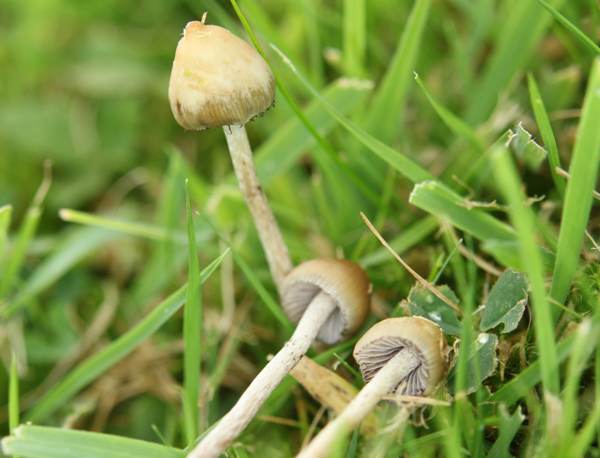
Etymology
Psilocybe, the genus name, means 'smooth head' - a reference to the silkily mooth, scaleless surface of caps of these grassland mushrooms. The specific epitet semilanceata comes from semi- meaning 'half'and -lanceata which means 'spear-shaped'. Some of these little mushrooms do indeed look like spears, although many have wiggly stems uncharacteristic of spear shafts.
The common name Magic Mushroom is, of course, a reference to the hallucinogenic nature of this grassland species
Psychoactive alkaloid content
This species contains the compound psilocybin. Because this substance, which occurs in Magic Mushrooms and some related fungi, occasionally causes alarming symptoms including vomiting, stomach pains and anxiety attacks, Liberty Caps are probably best treated with caution (some people even decide to treat them as poisonous).
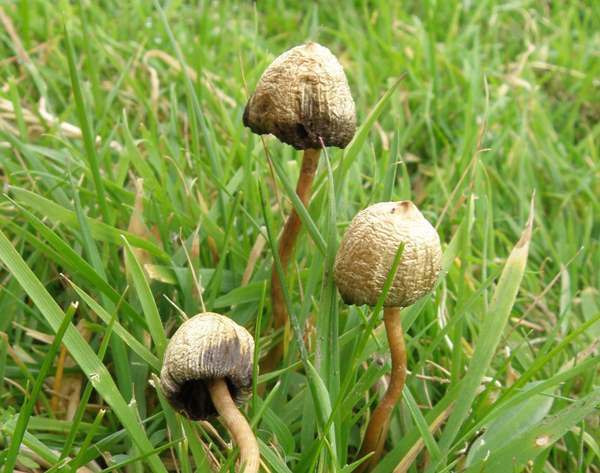
It is our understanding that it is illegal to possess or to sell psilocybin in the UK. As of July 2005, fresh psilocybin mushrooms are now also controlled. They are treated in UK Law in the same way as dried magic mushrooms, because whether fresh or dried they have the same Class A drug status as Heroin, LSD and Cocaine.
Taxonomic history
This species was first described in 1838 by the great Swedish mycologist Elias Magnus Fries, who named it Agaricus semilanceatus. (Most of the gilled mushrooms were included initially in the genus Agaricus!) In 1871 German mycologist Paul Kummer transferred this species to the genus Psilocybe, renaming it Psilocybe semilanceata. The etymology of this name is based on physical features: the generic name Psilocybe means 'smooth head', while semilanceata means 'half spear-shaped'.
Identification guide
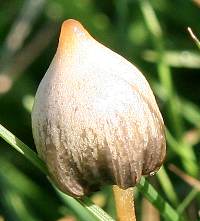 |
CapRanging from 0.5 to 2cm in diameter, the cream-coloured caps have striations that become more pronounced with age and in dry weather. The caps usually have a distinct pimple on the top. |
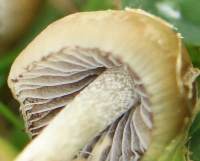 |
GillsThe olive-grey free gills turn purple-black as the spores mature. |
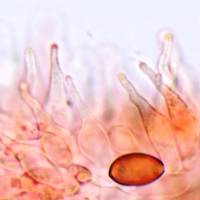 |
Above: cheilocystidia (cystidia standing out from the gill edges) of Psilocybe semilanceata. |
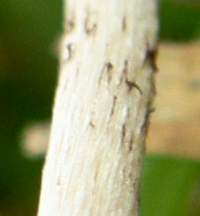 |
Stem2 to 3mm in diameter and 4 to 10cm tall, the slender cream stem of Psilocybe semilanceata is fibrous, usually wavy and sometimes coloured blue towards the base. |
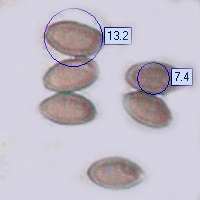 |
SporesEllipsoidal, smooth, 11.5-14.5 x 7-9μm. Spore printVery dark purple-brown. |
Odour/taste |
Musty odour. Do not taste Psilocybe semilanceata because it is hallucinogenic, and some people have required hospital treatment after eating this species. |
Habitat & Ecological role |
This poisonous saprobic grassland mushroom is most often found on upland pastures, notably on hill slopes. Although sometimes seen on lawns and in lowland meadows it does not grow on dung. |
Season |
These so-called Magic Mushrooms can be found in Britain and Ireland throughout summer and autumn. |
Similar species |
Panaeolus semiovatus, the Dung Roundhead, is usually larger and does not have a pointed cap. Panaeolina foenisecii, the Brown Mottlegill or Mower's Mushroom, is very similar in colour but is usually larger and does not have a pointed cap. |
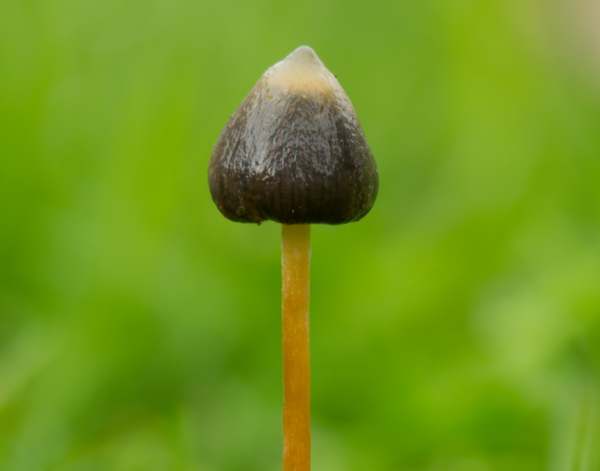
Reference Sources
Fascinated by Fungi, 2nd Edition, Pat O'Reilly 2016, reprinted by Coch-y-bonddu Books in 2022.
Dictionary of the Fungi; Paul M. Kirk, Paul F. Cannon, David W. Minter and J. A. Stalpers; CABI, 2008
Taxonomic history and synonym information on these pages is drawn from many sources but in particular from the British Mycological Society's GB Checklist of Fungi.
Acknowledgements
This page includes puictures kindly contributed by David Kelly.
Fascinated by Fungi. Back by popular demand, Pat O'Reilly's best-selling 450-page hardback book is available now. The latest second edition was republished with a sparkling new cover design in September 2022 by Coch-y-Bonddu Books. Full details and copies are available from the publisher's online bookshop...
